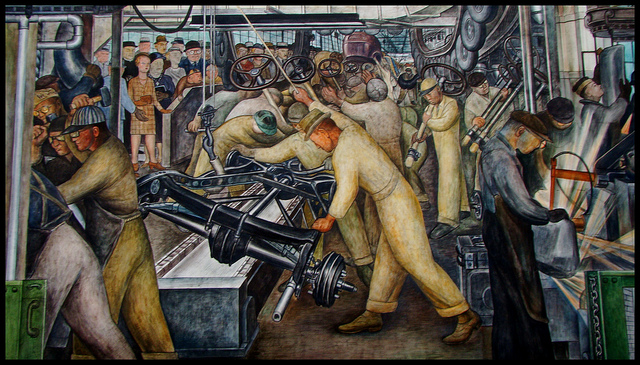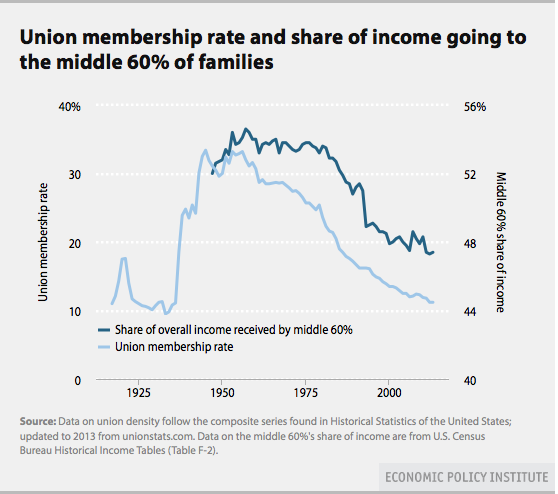
Do you ever feel like you never seem to be able to get ahead? That you work your whole life but, at the end of the month, the end of the year, you aren’t any further ahead than you were last month or last year?
This one chart goes a long way toward explaining exactly why that is:

As the chart shows, since the attacks on unions began back in the 50s and 60s and union membership began to drop, the share of income enjoyed by the middle 60 percent of families began to drop as well. In fact, the two correlate frighteningly well. Since the bottom 20 percent aren’t hogging up all that income, it’s clear that if you’re doing well, you will continue to do better and better. And if you’re in the middle, you will continue to do worse and worse until unions are completely extinguished.
It’s no surprise that those in positions of power and wealth spend such enormous amounts of time and resources maligning labor unions, demonizing union members, and doing everything they can politically to sap the collective bargaining power of workers.
The chart is from a new report out by the Economic Policy Institute (EPI) titled “The Benefits of Collective Bargaining – An Antidote to Wage Decline and Inequality”. Here are some other key findings from the report:
- The decline of collective bargaining has affected nonunion workers in industries or occupations that previously had extensive collective bargaining because their employers no longer raise wages toward the union-set standard as union membership rates decline.
- The decline of collective bargaining through its impact on union and nonunion workers can explain one-third of the rise of wage inequality among men since 1979, and one-fifth among women.
- Collective bargaining raises the wages and benefits more for low-wage workers than for middle-wage workers and least for white-collar workers, thereby lessening wage inequality.
- Collective bargaining also raises wages and benefits more for black, Asian, Hispanic, and immigrant workers, thereby lessening race/ethnic wage gaps.
- The decline of unions has affected middle-wage men more than any other group and explains about three-fourths of the expanded wage gap between white- and blue-collar men and over a fifth of the expanded wage gap between high school– and college-educated men from 1978 to 2011.
- The states where collective bargaining eroded the most since 1979 had the lowest growth in middle-class wages and the largest gap between rising productivity growth and middle-class wage growth.
In an op-ed at Medium.com, Lee Saunders, President of AFSCME, and Lawrence Mishel, President of the Economic Policy Institute make it clear who is on the side of workers, which groups are working against the interest of working Americans, and most importantly, how workers are responding to the continued attacks on their position:
Public policy is now on the side of the union-busters. Billionaires and CEOs have come together to push legislation that would weaken and destroy public sector collective bargaining. […]These policies do not reflect the will of the people. In Ohio in 2011, an overwhelming majority of voters rejected extreme attacks on the state’s public sector bargaining law and there is evidence that most Americans support unions and would join one if they could. Polling in 2005 showed that a majority of nonunion, non-managerial, workers would vote for union representation if they had the chance. That’s a big increase since the mid-1980s, when polls suggested that roughly 30 percent of that group would have voted for union representation.
Support for unions is growing as workers become frustrated with stagnant wages and limited bargaining power. In fact, in 2014, AFSCME grew its membership by 92,155 by training member activists how to organize. It’s clear that it’s time for a change. Candidates in the Republican Presidential primary are already positioning themselves as union buster-in-chief. But with the growing support for collective bargaining combined with the pressing concerns middle-class voters feel every day when it comes to their wages that haven’t kept up with the cost of living, they would be wise to reconsider this position. Candidates should compete to see who can give the strongest support to collective bargaining — the most important tool to combat wage stagnation and inequality.
Keep all of this in mind when you read conservative opinion pieces in your local newspaper suggesting that the problems of our country are due to the power of “union bosses”. That “union boss” is often your neighbor, your child’s teacher, your local government worker. What they are saying in their attacks is that workers have gained too much power through collective bargaining and it’s cutting into their profit margins. If corporations and those who do their bidding in state legislatures and in Congress can enact policies that diminish the collective bargaining power of workers, as the chart shows, a greater and greater share of our country’s wealth will flow to them.
And, when that happens, ALL American workers are harmed, not just those who are union members.
[CC image credit: Vasenka | Flickr]



